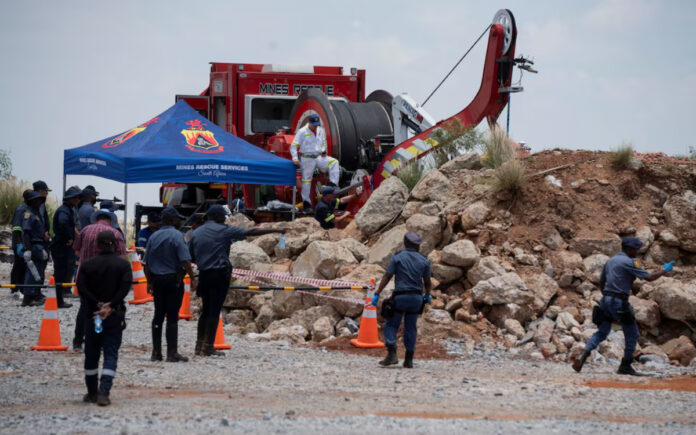Stilfontein: At least 78 illegal miners have been found dead in a South African mine following a months-long police blockade that trade unions have condemned as a “horrific” state crackdown. The rescue operation, ordered by the court, has revealed a dire humanitarian crisis at the Stilfontein gold mine, located southwest of Johannesburg.
So far, authorities have recovered 78 bodies and rescued 166 survivors, many of whom were emaciated and disoriented. Hundreds more miners are believed to be trapped nearly 2 kilometers below the surface. The rescue, initiated on Monday, involves a slow and painstaking process to bring survivors and deceased individuals to the surface.
Police Defend Blockade Amid Outcry
Since August, South African police had barred food and water from reaching the miners, known locally as “zama zamas,” until a December court ruling allowed volunteers to deliver essential supplies. Police spokesperson Athlenda Mathe defended the blockade, stating, “Our mandate was to combat criminality, and that is exactly what we’ve been doing. By providing food, water, and necessities to these illegal miners, it would be the police entertaining and allowing criminality to thrive.”
However, critics, including trade unions and opposition parties, argue the siege resulted in unnecessary deaths and suffering. The South African Federation of Trade Unions called the incident “one of the most horrific displays of state willful negligence in recent history.” The Democratic Alliance, the country’s second-largest party, has demanded an independent inquiry into the events at Stilfontein.
Arrests and Deportations Amid Rescue Efforts
All 166 survivors rescued so far have been arrested and charged with various offenses, including illegal immigration, trespassing, and illegal mining. None required hospitalization, according to police, and all were taken directly into custody.
Civil society activist Mzukisi Jam criticized the treatment of survivors, saying, “If you come out and you are able to walk, they take you straight to the cells.”
Rescue teams are using a red cylindrical metal cage to retrieve survivors and bodies. Each trip, which can hold about a dozen individuals, takes up to 45 minutes. Mannas Fourie, CEO of a private rescue firm, reported that even the miners remaining underground are eager to board the cage.
Jessica Lawrence from Lawyers for Human Rights described the situation as “incredibly distressing,” noting the emotional toll of seeing bodies being brought to the surface.
Also Read | Italy, Albania, UAE Unite for €1 Billion Adriatic Energy Link
Impact of Illegal Mining
Illegal mining costs South Africa’s economy hundreds of millions of dollars annually in lost revenues and royalties. Mining Minister Gwede Mantashe, speaking at the scene, remarked, “It’s a criminal activity. It’s an attack on our economy by foreign nationals in the main.”
Police reported that before the court-ordered rescue operation began, 1,576 miners emerged from the mine on their own. All were arrested, with 121 deported to their home countries, including Mozambique, Zimbabwe, and Lesotho. Only 21 of the detained miners were South African citizens.
Also Read | Kashmir’s Saffron Farmers Explore Indoor Cultivation Amid Climate Threats
The zama zamas, whose name originates from an isiZulu phrase meaning “to take a chance,” typically operate in abandoned mines, often under the control of violent criminal syndicates.



